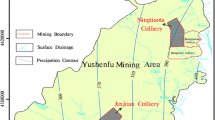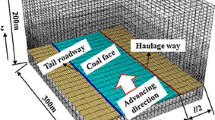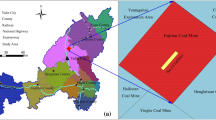Abstract
Numerous mining-induced water inrush hazards have been recorded in northern and eastern China, wherein landforms comprise thick unconsolidated layers. To prevent such hazards, the height of the water conducting fractured zone (WCFZ) must be determined in advance. This study presents a method to predict the height of this zone by determining the location of the key strata (KS) and considering the overburden load transfer under an arch structure in the unconsolidated layers. When the distance between the primary key stratum (PKS) and coal seam is more than 7–10 × M, where M refers to the mining height, the WCFZ tends to extend up to the floor level of the first KS, approximately the same distance (7–10 × M) above the mining seam, thereby making the height of this zone equal to the distance between the KS and coal seam. When the vertical distance between the PKS and coal seam is less than 7–10 × M, the height of this zone tends to be equal to or greater than the thickness of the bedrock strata. The theoretical results were verified by field observations.
Zusammenfassung
In den nördlichen und östlichen Regionen Chinas sind zahlreiche bergbauinduzierte Wassereinbrüche im Zusammenhang mit der Verbreitung mächtiger, unkonsolidierter Schichten zu verzeichnen. Um solche Gefährdungen zu verhindern, muss die Mächtigkeit wasserführender Bruchzonen im Voraus bestimmt werden. In dieser Studie wird eine Methode zur Vorhersage von Mächtigkeiten wasserführender Bruchzonen vorgestellt, welche die Lage von sog. Schlüsseleinheiten (key strata KS) unter Berücksichtigung des Überlagerungsdrucks des Deckgebirges unterhalb von Gewölbestrukturen in unkonsolidierten Schichten einbezieht. Wenn der Abstand zwischen der primären Schlüsseleinheit (PKS) und dem Kohleflöz mehr als das 7–10-fache von M beträgt, wobei M die Mächtigkeit des Kohleflözes ist, erstreckt sich die wasserführende Bruchzone in der Regel bis zur Basis der ersten Schlüsseleinheit (KS), welche sich ungefähr im gleichen Abstand (7–10 mal M) über dem Abbaugebiet befindet. Somit entspricht die Mächtigkeit der wasserführenden Bruchzone dem Abstand zwischen KS und dem Kohleflöz. Wenn der vertikale Abstand zwischen der primären Schlüsseleinheit (PHS) und dem Kohleflöz weniger als das 7–10-fache von M beträgt, ist die Mächtigkeit der wasserführenden Bruchzone in der Regel gleich oder größer der Mächtigkeit der Festgesteinseinheit unterhalb von unkonsolidierten Gesteinen. Die theoretischen Ergebnisse werden durch Feldbeobachtungen aus China bestätigt.
Resumen
Se han registrado numerosos riesgos de irrupción de agua inducidos por la minería en las regiones norte y este de China, donde los accidentes geográficos incluyen gruesas capas no consolidadas. Para evitar estos riesgos, la altura de agua fluyendo por la zona de fractura debe determinarse de antemano. Este estudio presenta un método para predecir la altura de la zona de fractura que fluye del agua mediante la determinación de la ubicación de los estratos clave (KS) con la consideración de la ley de transferencia de la sobrecarga bajo la estructura del arco en los efectos de capas no consolidadas (ASUL). Cuando la distancia entre el estrato clave primario (PKS) y la capa de carbón es mayor que 7-10 veces M, donde M se refiere a la altura de extracción de carbón, el agua fluyendo por la zona de fractura tiende a extenderse hasta el nivel del piso del primer KS, ubicado aproximadamente la misma distancia (7–10 veces M) sobre la veta, haciendo que la altura de agua fluyendo por la zona de fractura sea igual a la distancia entre KS y la veta. Cuando la distancia vertical entre PKS y la capa de carbón es menor de 7 a 10 veces M, la altura de agua fluyendo por la zona de fractura tiende a ser igual o mayor que el espesor de los estratos de roca madre. Los resultados teóricos se verificaron mediante observaciones de campo realizadas en China.
抽象
基于覆岩承载结构的导水裂隙带高度预测方法 中国北部和东部的厚松散层地区已经发生过多次采矿引起的突水事故。为防止此类灾害,必须提前确定导水裂隙带高度。在考虑松散层拱结构(ASUL)荷载传递规律的基础上,确定关键层(KS)位置,提出了一种预测导水裂隙带高度的方法。 当主关键层(PKS)与煤层间距离大于7-10倍煤层采煤高度(M)时,导水裂隙带将向上发展至第一关键层(KS)底部,第一关键层也位于开采煤层上方约7-10倍采高的位置;此时,导水裂隙带高度等于关键层(KS)与煤层的间距。当主关键层(PKS)与煤层的垂直间距小于7-10倍采高(M)时,导水裂隙带高度将等于或大于基岩厚度。系列野外监测(中国)已经验证了该理论的可靠性。








Similar content being viewed by others
References
Cai W, Dou LM, Gong SY, Li ZL, Yuan SS (2015) Quantitative analysis of seismic velocity tomography in rock burst hazard assessment. Nat Hazards 75(3):2453–2465
Einstein HH, Schwartz CW (1979) Simplified analysis for tunnel supports. J Geotech Eng Div 105:499–518
Fisne A, Esen O (2014) Coal and gas outburst hazard in Zonguldak Coal Basin of Turkey, and association with geological parameters. Nat Hazards 74(3):1363–1390
Ghabraie B, Ren G, Zhang X, Smith J (2015a) Physical modelling of subsidence from sequential extraction of partially overlapping longwall panels and study of substrata movement characteristics. Int J Coal Geol 140:71–83
Ghabraie B, Ren G, Smith J, Holden L (2015b) Application of 3D laser scanner, optical transducers and digital image processing techniques in physical modelling of mining–related strata movement. Int J Rock Mech Min Sci 80:219–230
Guo HJ, Ji M, Chen K, Zhang ZL, Zhang YD, Zhang ML (2018) The feasibility of mining under a water body based on a fuzzy neural network. Mine Water Environ 37(4):703–712
Heinz HK (1984) Applications of the new Austrian tunnelling method in urban areas. M.Sc. Thesis, Department of civil engineering, University of Alberta
Huang QX (2005) Studies on load-transmitting factor of thick sandy soil layer on key roof stratum in shallow seam mining. Chin J Geotech Eng 27(6):672–676
Kim HJ, Eisenstein Z, Chae BG, Jeong CH (2006) Estimates of stress reduction factors for the tunnel design. Tunn Undergr Space Technol 21(3):451–456
Liu YF, Wang SD, Wang XL (2014) Development characteristics of water flowing fractured zone of overburden deep buried extra thick coal seam and fully-mechanized caving mining. J China Coal Soc 39(10):1970–1976
Liu SL, Li WP, Wang QQ (2018) Height of the water-flowing fractured zone of the Jurassic coal seam in northwestern China. Mine Water Environ 37(2):312–321
Moebs NM, Sames GP (1989) Water—a hazard and a nuisance. Coal 26(10):60–63
Muir Wood AM (1975) The circular tunnel in elastic ground. Geotechnique 25(1):115–127
Panet M, Guenot A (1982) Analysis of convergence behind the face of a tunnel. Tunnelling, the Institution of Mining and Metallurgy, pp 197–204
Qian MG, Miao XX, Xu JL (1996) Theoretical study of key stratum in ground control. J China Coal Soc 21(3):225–230
Ricka A, Kuchovsky T, Sracek O, Zeman J (2010) Determination of potential mine water discharge zones in crystalline rocks at Rozna, Czech Republic. Environ Earth Sci 60(6):1201–1213
State Bureau of Coal Industry (2000) Regulations of coal pillar design and extraction for buildings, water bodies, railways, main shafts and roadways. Coal Industry Press, Beijing
Wang F, Jiang BY, Chen SJ, Ren MZ (2019a) Surface collapse control under thick unconsolidated layers by backfilling strip mining in coal mines. Int J Rock Mech Min Sci 113:268–277
Wang F, Xu JL, Xie JL (2019b) Effects of arch structure in unconsolidated layers on fracture and failure of overlying strata. Int J Rock Mech Min Sci 114:141–152
Xu JL (2016) Distribution law of mining-induced strata fractures and its applications. China University of Mining and Technology Press, Xuzhou
Xu JL, Qian MG, Ma WD, Zhao HY (2001) Discussion on load problem in physical and numerical simulation of strata movement. J China Univ Min Tech 30(3):252–255
Xu DJ, Peng SP, Xiang SY, Liang MX, Liu WM (2016) The effects of caving of a coal mine’s immediate roof on floor strata failure and water inrush. Mine Water Environ 35(3):337–349
Xuan DY, Xu JL (2014) Grout injection into bed separation to control surface subsidence during longwall mining under villages: case study of Liudian coal mine, China. Nat Hazards 73(2):883–906
Yin DW, Chen SJ, Liu XQ, Ma HF (2018) Effect of joint angle in coal on failure mechanical behavior of roof rock-coal combined body. Q J Eng Geol Hydroge 51(2):202–209
Zhu ST, Feng Y, Jiang FX (2016) Determination of abutment pressure in coal mines with extremely thick alluvium stratum: a typical kind of rockburst mines in China. Rock Mech Rock Eng 49(5):1943–1952
Acknowledgments
This research was supported by the project supported by the National Natural Science Foundation of China (51904162), Shandong Provincial Natural Science Foundation, China (ZR2018BEE001), the Taishan Scholars Project, and the Scientific Research Foundation of SDUST for Recruited Talents (2017RCJJ006). We thank Editage [http://www.editage.cn] for English language editing. Thanks also to the anonymous reviewers for their constructive comments and suggestions.
Author information
Authors and Affiliations
Corresponding author
Rights and permissions
About this article
Cite this article
Wang, F., Xu, J., Chen, S. et al. Method to Predict the Height of the Water Conducting Fractured Zone Based on Bearing Structures in the Overlying Strata. Mine Water Environ 38, 767–779 (2019). https://doi.org/10.1007/s10230-019-00638-w
Received:
Accepted:
Published:
Issue Date:
DOI: https://doi.org/10.1007/s10230-019-00638-w




